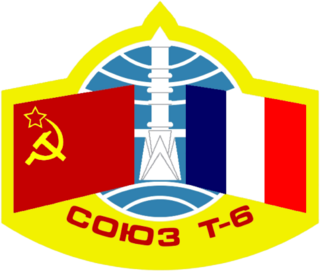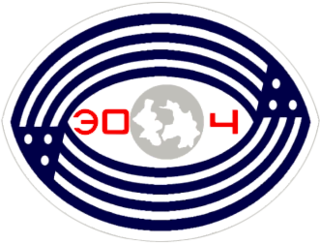
Mir was a space station that operated in low Earth orbit from 1986 to 2001, operated by the Soviet Union and later by Russia. Mir was the first modular space station and was assembled in orbit from 1986 to 1996. It had a greater mass than any previous spacecraft. At the time it was the largest artificial satellite in orbit, succeeded by the International Space Station (ISS) after Mir's orbit decayed. The station served as a microgravity research laboratory in which crews conducted experiments in biology, human biology, physics, astronomy, meteorology, and spacecraft systems with a goal of developing technologies required for permanent occupation of space.

The Salyut programme was the first space station programme, undertaken by the Soviet Union. It involved a series of four crewed scientific research space stations and two crewed military reconnaissance space stations over a period of 15 years, from 1971 to 1986. Two other Salyut launches failed. In one respect, Salyut had the task of carrying out long-term research into the problems of living in space and a variety of astronomical, biological and Earth-resources experiments, and on the other hand the USSR used this civilian programme as a cover for the highly secretive military Almaz stations, which flew under the Salyut designation. Salyut 1, the first station in the programme, became the world's first crewed space station.

Salyut 2 (OPS-1) was a Soviet space station which was launched in 1973 as part of the Salyut programme. It was the first Almaz military space station to fly. Within two weeks of its launch, the station had lost altitude control and depressurized, leaving it unusable. Its orbit decayed and it re-entered the atmosphere on 28 May 1973, without any crews having visited it.

Salyut 5, also known as OPS-3, was a Soviet space station. Launched in 1976 as part of the Salyut programme, it was the third and last Almaz space station to be launched for the Soviet military. Two Soyuz missions visited the station, each crewed by two cosmonauts. A third Soyuz mission attempted to visit the station, but failed to dock, whilst a fourth mission was planned but never launched.

Salyut 6, DOS-5, was a Soviet orbital space station, the eighth station of the Salyut programme. It was launched on 29 September 1977 by a Proton rocket. Salyut 6 was the first space station to receive large numbers of crewed and uncrewed spacecraft for human habitation, crew transfer, international participation and resupply, establishing precedents for station life and operations which were enhanced on Mir and the International Space Station.

Soyuz T-6 was a human spaceflight to Earth orbit to the Salyut 7 space station in 1982. Along with two Soviet cosmonauts, the crew included a Frenchman, Jean-Loup Chrétien.

Soyuz T-15 was a crewed mission to the Mir and Salyut 7 space stations and was part of the Soyuz programme. It marked the final flight of the Soyuz-T spacecraft, the third generation Soyuz spacecraft, which had been in service for seven years from 1979 to 1986. This mission marked the first time that a spacecraft visited, and docked with, two space stations in the same mission.

Progress 1, was a Soviet unmanned Progress cargo spacecraft which was launched in 1978 to resupply the Salyut 6 space station. It was the maiden flight of the Progress spacecraft, and used the Progress 7K-TG configuration. It carried supplies for the EO-1 crew aboard Salyut 6, which consisted of Soviet cosmonauts Yuri Romanenko and Georgy Grechko. The cargo carried by Progress 1 also included equipment for conducting scientific research, and fuel for adjusting the station's orbit and performing manoeuvres.
Progress M1-2 was a Progress spacecraft which was launched by Russia in 2000 to resupply the Mir space station. It was a Progress-M1 11F615A55 spacecraft, with the serial number 252.

Progress 7K-TG, was a Soviet uncrewed spacecraft used to resupply space stations in low Earth orbit. Forty three flew, delivering cargo to Salyut 6, Salyut 7, and Mir. It was the first version of the Progress spacecraft to fly, and spawned later derivatives including the Progress-M which replaced it, and the later Progress-M1.

Mir EO-4 was the fourth long-duration expedition to the Soviet space station Mir. The expedition began in November 1988, when crew members Commander Aleksandr Volkov and Flight Engineer Sergei Krikalev arrived at the station via the spacecraft Soyuz TM-7. The third crew member of EO-4, Valeri Polyakov, was already aboard Mir, having arrived in August 1988 part way through the previous expedition, Mir EO-3.

Progress 2 was an unmanned Progress cargo spacecraft launched by the Soviet Union in 1978 to resupply the Salyut 6 space station. It used the Progress 7K-TG configuration, and was the second Progress mission to Salyut 6. It carried supplies for the EO-2 crew aboard Salyut 6, as well as equipment for conducting scientific research, and fuel for adjusting the station's orbit and performing manoeuvres.

Progress 3 was an unmanned Progress cargo spacecraft launched by the Soviet Union in 1978 to resupply the Salyut 6 space station. It used the Progress 7K-TG configuration, and was the third Progress mission to Salyut 6. It carried supplies for the EO-2 crew aboard Salyut 6, as well as equipment for conducting scientific research, and fuel for adjusting the station's orbit and performing manoeuvres.







